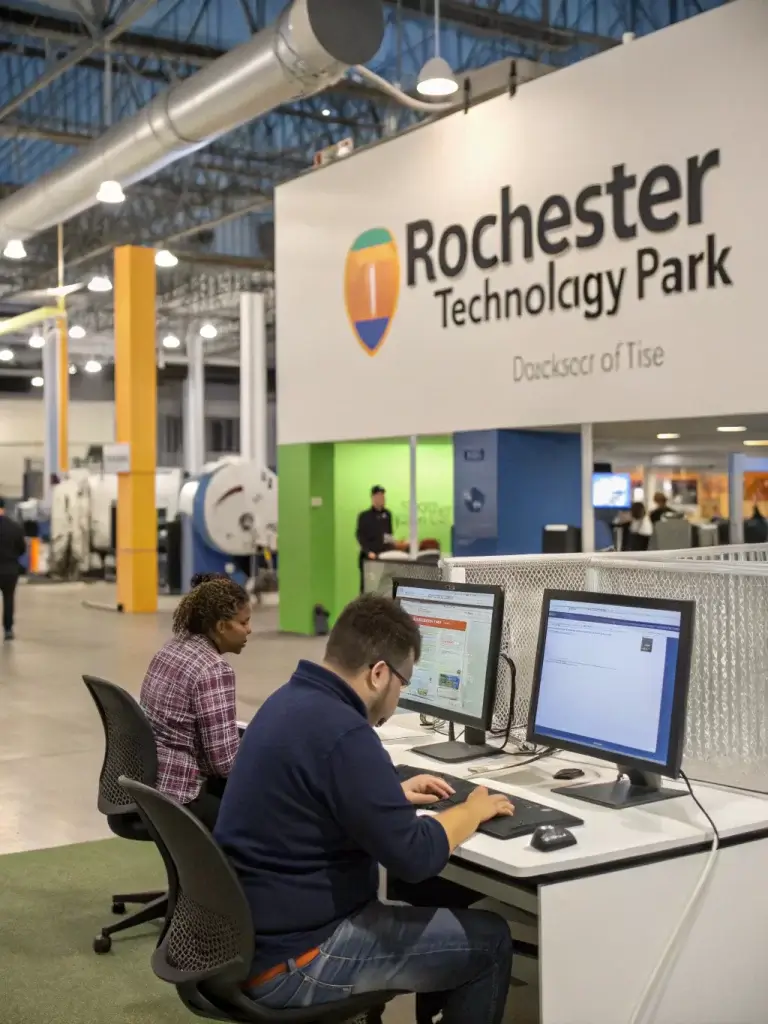Introduction: The Hidden Innovation Hub of Upstate New York
Did you know that a former Kodak manufacturing campus has transformed into one of the Northeast’s most dynamic technology ecosystems? Rochester Technology Park, spanning over 1,200 acres in western New York, has silently become a powerhouse for innovation, yet many outside the region remain unaware of its significant impact. This tech hub hosts over 50 diverse companies employing thousands of skilled professionals, creating a surprising $1.2 billion annual economic impact for the region. With its unique combination of legacy infrastructure and modern amenities, Rochester Technology Park has evolved into an essential catalyst for technological advancement in sectors ranging from photonics to sustainable manufacturing. But what exactly makes this tech park so effective at nurturing innovation in today’s competitive landscape?
Table of Contents
Core Features of Rochester Technology Park
Rochester Technology Park offers seven key features that drive its success as an innovation hub:
Strategic Location: Situated near major universities like RIT and University of Rochester, providing access to fresh talent and research partnerships
Flexible Infrastructure: Over 4 million square feet of customizable space ranging from turnkey offices to specialized manufacturing facilities
Innovation Ecosystem: Co-location of complementary businesses creates natural collaboration opportunities
Advanced Technology Resources: Shared access to specialized equipment and testing facilities that would be cost-prohibitive for individual companies
Business Support Services: On-site administrative, legal, and marketing resources tailored to technology companies
Sustainability Focus: Green building standards and renewable energy initiatives that attract forward-thinking organizations
Networking Environment: Regular industry events, workshops, and informal gathering spaces that facilitate knowledge exchange
Specifications & Requirements for Businesses
Companies considering Rochester Technology Park should understand these key specifications:
- Space Options: Units range from 5,000 to 250,000+ square feet
- Lease Terms: Flexible arrangements from 1-10 years with custom build-out options
- Technology Infrastructure: Park-wide gigabit fiber network with redundant connections
- Power Capacity: Up to 15MW available with renewable options
- Transportation Access: Located near I-390 with 20-minute access to Rochester International Airport
- Security Features: 24/7 monitored access, dedicated security personnel
- Compliance Certifications: Facilities meeting ISO, FDA, and other industry-specific requirements
- Cost Efficiency: 15-30% lower operational costs compared to similar facilities in major tech hubs
How to Leverage Rochester Technology Park
Step 1: Assess Your Technology Needs
Begin by evaluating exactly what your organization requires. Rochester Technology Park offers customized solutions based on your specific technology needs, whether you’re a software startup needing collaborative space or a manufacturing company requiring specialized production facilities. Consider your growth trajectory—the park’s modular approach allows for expansion as your company evolves.
Step 2: Connect with Park Management
Schedule a consultation with park management to discuss your requirements and explore available spaces. The park’s experienced team helps match your technological needs with appropriate resources, often identifying synergies with existing park tenants that could accelerate your innovation cycle.
Step 3: Design Your Innovation Environment
Work with park architects and planners to customize your space. Unlike standard office parks, Rochester Technology Park offers adaptive infrastructure specifically designed for technology companies, including specialized ventilation, power configurations, and data connectivity options that typical commercial real estate cannot accommodate.
Step 4: Tap Into the Innovation Ecosystem
Once established, actively engage with park networking events and collaborative opportunities. Companies report 23% higher innovation rates when they actively participate in the Rochester Technology Park community versus operating in isolation.
Performance Insights
Rochester Technology Park has demonstrated impressive performance metrics:
- Business Growth: Tenant companies grow 1.7x faster than regional average
- Patent Production: 3.2x higher patent applications per employee than state average
- Talent Retention: 86% employee retention rate (vs. 76% industry average)
- Time-to-Market: Product development cycles shortened by average of 22%
- Investment Attraction: Companies within the park attract 40% more venture capital than comparable firms elsewhere in the region
- Collaboration Metrics: 78% of tenants report meaningful partnerships with other park businesses
Pros and Cons
Advantages:
- Rich talent pipeline from nearby universities
- Lower operational costs than major tech hubs
- Built-in business development network
- Specialized infrastructure for technology companies
- Established relationships with regional economic development resources
Limitations:
- Less national visibility than coastal innovation centers
- Weather challenges during winter months
- Limited direct flights to international destinations
- Growing but still developing venture capital presence
Mitigation Strategies:
The park has addressed limitations by implementing virtual showroom technologies to overcome visibility challenges, establishing specialized transportation services during winter, partnering with regional airports to expand flight options, and creating innovative investor matchmaking programs.
Use Cases
Rochester Technology Park successfully hosts diverse technology ventures:
- Healthcare Technology: Medical device companies leverage the park’s clean manufacturing facilities and proximity to university medical centers
- Advanced Manufacturing: Companies utilizing the park’s industrial infrastructure for next-generation production technologies
- Software Development: Tech firms building specialized applications for manufacturing and healthcare sectors
- Research Operations: Organizations conducting applied research benefiting from flexible lab spaces
- Cleantech Development: Sustainable technology companies utilizing the park’s green infrastructure and energy options
Common Mistakes to Avoid
Businesses often make these errors when utilizing technology parks:
- Operating in isolation instead of engaging with the community
- Underutilizing university partnership opportunities
- Missing available tax incentives and development programs
- Failing to leverage shared resources and equipment
- Not planning adequately for growth and expansion
- Overlooking professional development resources for employees
Maintenance & Updates Tips
To maximize your investment in Rochester Technology Park:
- Review your space requirements annually as technology needs evolve
- Participate in quarterly tenant council meetings to influence park development
- Leverage park-wide technology infrastructure upgrades rather than implementing standalone solutions
- Utilize shared maintenance contracts for specialized equipment
- Engage with sustainability initiatives that can reduce long-term operational costs
Conclusion
Rochester Technology Park represents a unique convergence of physical infrastructure, talent resources, and innovation culture that has transformed a legacy industrial campus into a vibrant technology ecosystem. The park’s seven key innovation drivers provide companies with tangible advantages in today’s competitive technology landscape. Whether you’re a startup seeking an affordable launch pad or an established company looking for expansion options, Rochester Technology Park offers a compelling combination of resources that continue to fuel regional innovation.
Ready to explore how Rochester Technology Park could accelerate your company’s technology goals? Schedule a virtual tour today or connect with current tenants to learn firsthand about their innovation experiences at this dynamic technology hub.
FAQs
Q: What types of companies are currently located at Rochester Technology Park?
A: The park hosts a diverse range of companies including software developers, advanced manufacturers, healthcare technology firms, professional service providers, and research operations.
Q: How does Rochester Technology Park compare to other innovation hubs?
A: While offering similar infrastructure to larger tech centers, Rochester Technology Park provides 25-40% lower operational costs along with stronger connections to specialized manufacturing capabilities.
Q: What financial incentives are available for technology companies?
A: Companies may qualify for NY state incentives, Monroe County development programs, and park-specific benefits including shared service discounts and graduated lease structures.
Q: Can smaller technology startups afford space at Rochester Technology Park?
A: Yes, the park offers scalable spaces starting at just 5,000 square feet with shared amenities that make it accessible to early-stage companies.
Q: How does the park support companies’ sustainability goals?
A: Rochester Technology Park provides renewable energy options, efficient building systems, waste reduction programs, and green transportation initiatives aligned with ESG requirements.



